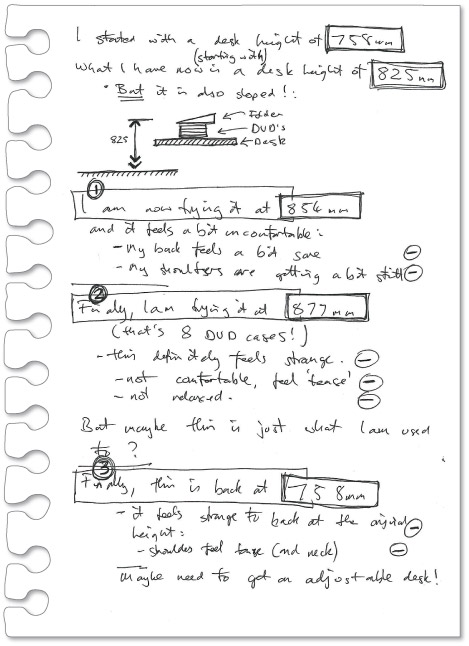4.2 Practical variation
One way to approach a design problem is to use your own knowledge and experience. You may not be a furniture, automotive or aeroplane designer but you probably have considerable experience of sitting down! Making use of this personal knowledge might seem trivial, but it is the start of all creative problem solving. The key is turning this personal knowledge into information you can use in any design process.
Activity 7 Seat and desk height
Measure the height from the floor to the seat and the desk or table where you study.
Make your measurements in millimetres and note them down somewhere for use in the next activity. Even if you don’t usually study at a desk or table, find a place like this that you can use for this activity (and the next one).
Calculate the difference between these two heights in mm.
Discussion
For example, a typical desk might be 758 mm above the floor, and the seat 540 mm above the floor.
The difference between these two heights is 758 mm − 540 mm = 218 mm.
What you have done in Activity 7 is to measure something that already exists. You have an existing desk and you have given a value to a property of it. Now, when you talk to other people about your desk you’ll be able to state the height in a way that they will understand.
Before you take this measured height as the perfect desk height, it is worth checking this assumption. Once again you will use a practical method to do this.
Activity 8 Experimenting with desk heights
Adjust the height of your desktop by using accessible materials you have around you. For example, you could use a flat surface like a tray propped up on books, or a folder with some DVD cases underneath it. What you are looking for is some way to quickly and easily adjust a stable surface that you are able to use. If you have quite a high desk, then you might want to find a lower one, such as a table, to start the activity.
Try working on your desk at different heights, and note down how it feels to work at each height. (Is it more or less comfortable than the original height?) Once you have found a height that feels comfortable, take a note of the difference in height from what you were using previously.
Take a few pictures of your adjusted desktop. A discussion of this activity will follow in the main text – but don’t read on until you have tried it.
Discussion
Here is one person’s answer.
I used DVD cases to prop up a folder. This did actually change the way I wrote notes quite dramatically. At a higher height (about 3 DVD boxes) it felt a lot more comfortable.
Higher than this and it felt a bit strange – not comfortable for my shoulders and arms.
Here’s a picture of the notes I took:
As I went through these tests I measured each one as a full height from the floor. But I could easily have measured the difference between the desk and the height of the folder. I might even have measured it in DVD cases – one case is about 16 mm, and I used 4 of them
(4 × 16 mm = 64 mm).
This all suggests I might not have my desk high enough – a bit of a problem considering it’s screwed to the wall … I might need to come up with a creative solution to that as the next problem.
This technique is called design prototyping, where you create a quick physical mock-up of a design idea in order to test some aspect of that idea. It is exceptionally useful because it is quick and simple, and you get instant feedback on the problem you are exploring. Almost all design problems can be prototyped (even systems and processes) and this is a key method in any design engineer’s toolkit.
The prototype you have just made can also provide two types of information. When you increased the height of your desk you might have noted whether it felt uncomfortable and whether this discomfort is acceptable or not. Or you might have compared two heights to see which one is more (or less) comfortable. You are no longer only measuring height; you are also making judgements about the desk at these heights. In both cases you now have new items of information, and they are of different types. The height of the desk is quantitative information, while what you think and feel about the new height is qualitative information.
The height you are working with is fine for one person (you!) and it is possible to imagine that other people of about your own size might also be quite happy with that height. But the original problem was more general: what height should you use to design a desk to ‘fit’ people? In other words, you are interested in finding a height that many people will find comfortable, and one way to do this is to find out how many people might find a particular height comfortable.
To expand the problem beyond your own experience you need to use other techniques.

